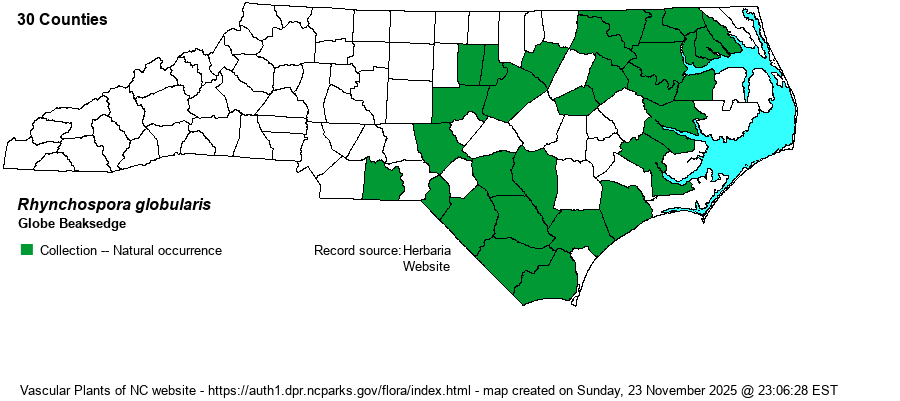| Author | (Chapman) Small | |
| Distribution | Coastal Plain, Sandhills (local), and lower Piedmont (local). Records and reports from farther west need a careful ID check versus R. recognita.
Mostly Coastal Plain, DE to southern FL and central TX; central TN; disjunct to CA. | |
| Abundance | Fairly common in the Coastal Plain, though scarce to absent near the eastern coast and barrier islands/Outer Banks. Rare or uncommon in the Sandhills and lower Piedmont. | |
| Habitat | Wet to moist pine savannas and flatwoods, depression pond margins, roadside ditches. | |
| Phenology | Flowering and fruiting June-September. | |
| Identification | Rhynchospora recognita and R. pinetorum have been split off from R. globularis. R. recognita differs in having longer seeds (1.4-1.8 mm vs. 1.3-1.5 mm) and wider leaves (up to 5 mm wide vs. up to 3 mm wide in R. globularis). R. pinetorum differs in having the seed bristles at least 2/3 the length of the seed body, versus usually less than 1/2 the length of the seed body in R. globularis. | |
| Taxonomic Comments | Rhynchospora recognita and R. pinetorum have been split off from R. globularis.
Members of the genus Rhynchospora -- mainly called beaksedges but also called beakrushes -- are mostly Coastal Plain in distribution and are important members of our longleaf pine savannas, flatwoods, streamheads, depression ponds, Carolina bays, and beaver ponds. They vary from small and wiry to large and coarse. Keys concentrate on features of the achenes (seeds) and the shape and arrangement of the flower clusters (spikelets). The seeds may or not have bristles at their base; bristle number, length, and toothing are critical characters. Size and shape of the seed beaks is also critical. The drawings in Godfrey & Wooten (1979) are extremely helpful. The genus now includes Dichromena, the white-topped sedges. | |
| Other Common Name(s) | None | |
| State Rank | S4 | |
| Global Rank | G5 | |
| State Status | | |
| US Status | | |
| USACE-agcp | FACW link |
| USACE-emp | FACW link |

